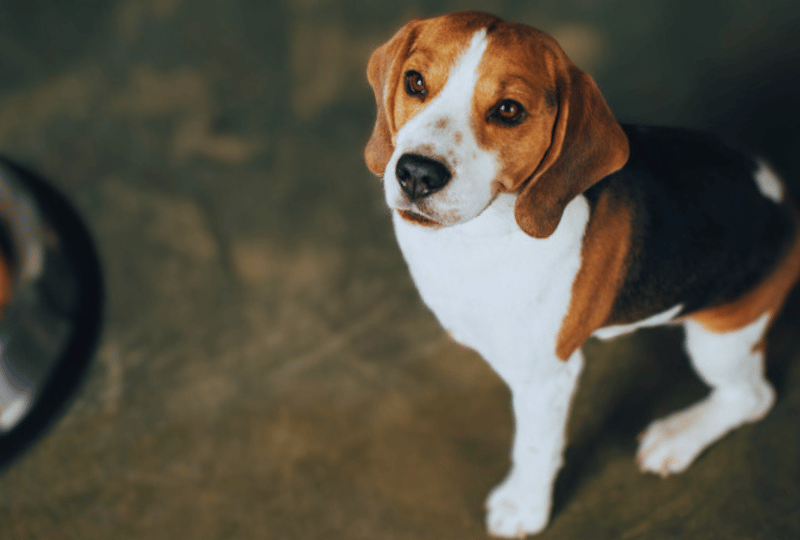If you’re an experienced dog owner, it’ll be no surprise to you when your dog does something that other people might call strange. Humping is one of those things!
After your dog eats, you might find them humping something like a toy, a blanket, or their bed, or sometimes, even yourself!
I’ve had more than a few dog training clients at our Colorado Springs location ask about this so I expect that people around the country are asking too! That’s why we sat down with Not A Bully’s advising veterinarian Dr. Nita Patel to take a closer look. Here’s what we came up with:
Dogs may hump after eating due to various reasons, including excitement and excess energy, as a good meal can cause a spike in blood glucose levels, leading to bursts of energy or “zoomies.” Anxiety is another common cause, where humping serves as a self-soothing behavior for dogs feeling stressed or overwhelmed.
Young dogs entering adolescence might hump due to hormonal changes, emphasizing the importance of spaying or neutering.
Seeking attention is also a motivation and dogs might hump to get reactions from their owners. With enough time, humping can become a habit, regardless of what started the behavior. Hunger for more food can lead dogs to hump as a way of communicating their needs, though this is less common. Redirection and positive reinforcement can help change the behavior but will take time and patience.
That’s the quick overview but we’ll take a much closer look at each explanation to help you figure out which explanation makes the most sense for your pup and help you figure out what to do about it. Let’s get started!
Reason 1: Your Dog Is Excited and Has Extra Energy
Dr. Nita Patel explains that “A good meal spikes your dog’s blood glucose level and gives that immediate spike in energy. Some dogs don’t know what to do with this energy and will hump as a form of energy release.”
This explains the behavior in most dogs and if you’re seeing signs of the zoomies in your pup after their meal, a burst of energy from food and excitement from mealtime explains the humping. If you’re not familiar, zoomies (or more officially called frenetic random activity periods or FRAPs) are the random bursts of energy that cause your dog to do actions like running or spinning.
If you believe your dog is humping after eating because they have excess energy, finding ways to tire them out can help you and your pup.
Remember to focus on both mental and physical stimulation! That could be an extra walk before mealtime or feeding your dog with a puzzle toy or snuffle mat that lets them burn off energy before your pup turns to humping!
Reason 2: Your Dog Could Be Anxious
Outside of excitement, anxiety is the most common explanation I see when training clients report misplaced humping.
Humping is commonly used as a self-soothing behavior for dogs which means that it can serve as a way for dogs to relieve stress or anxiety, manage excitement (as we saw in the first explanation), or simply comfort themselves in situations where they might feel overwhelmed or in need of reassurance.
If humping started suddenly, you’ll want to look for any change in the household that could have increased stress or anxiety around mealtime. That could be a new pet that’s showing interest in your dog’s meal, a new guest, loud noises, or anything else that your dog may find stressful.
You can give your dog other ways to manage their stress and anxiety and once again, extra mental and physical stimulation can help.
Reason 3: Your Dog Wants Attention (And You Could Be Encouraging Humping)
Your dog might hump you after eating because they want to get your attention. Typically, if you notice your dog humping in the corner of the room you’re going to take notice. For your dog, this attention could be interpreted as good whether it’s laughing, asking what they’re doing in a funny voice, or even trying to give them something else to do.
Just as we positively reinforce our dogs to sit or come when called with praise and treats, the attention your dog gets when they hump after dinner could be enough to keep the behavior going. Dr. Patel further explains that humping to get attention after mealtime is “referred to as a displacement behavior as your dog is partaking in another attention-seeking way that they know will garner a reaction from you.”
Again, focusing on mental and physical stimulation can be helpful to mitigate this behavior. Interactive exercise will not only help your dog burn off extra energy but will also give them the extra attention they’re looking for. Ignoring and redirecting the behavior will ensure that you don’t inadvertently positively reinforce the behavior too.
Reason 4: Your Dog Does It Out Of Habit
Whether it started as a way to get attention, a self-soothing behavior, or anything else, with enough time humping after mealtime can become a habit.
The likelihood of habit forming as a reason for humping post-eating is higher if the behavior has been ongoing for a considerable period. This is especially true if the behavior was initially triggered by other factors, such as excitement or attention-seeking, and was inadvertently encouraged by your dog’s environment or even your response.
Reason 5: Your Dog Could Be Aroused
If your dog is young and entering adolescence, from 6 months to around a year, hormonal levels may be impacting their desire to hump. It’s one of the many reasons to spay and neuter, before it becomes a habit as hormone-driven habits can be much harder to break than habits related to anxiety or excitement.
However, if the humping is only occurring after eating, then excitement is likely a big contributor still.
Reason 6: Your Dog Wants More Food
If your dog humps you, their toys, or their bed after eating, this may be because they want more of that tasty food. While plenty of dogs will ask for treats and food even when they’re not hungry (thanks to their scavenger instincts), Dr. Nita Patel points out that humping after mealtime “could also be indicative that their current food is not giving them the nutrition they need so they’re still hungry after their meal”
It might not make immediate sense to us, but humping could be one of the few ways that your dog knows they can get your attention. It’s not the clearest message but your dog could be doing their best to communicate their needs.
Still, this is one of the less likely reasons and a burst of excitement and energy will explain this behavior for most dogs. But if other explanations aren’t making sense, check your food’s label to make sure your dog is getting enough for their weight and consider talking to your veterinarian.
It’s Likely Not Related To Dominance
The idea of dominance and strict social structures in dogs has been debunked over the years but that concept keeps showing up. While humping can be a part of social structures, it’s not so simple as “alpha” (also debunked) dog humps lower status dogs. Instead, explanations like excitement, anxiety, habit, and hormonal motivations are much more likely explanations for post-meal humping.
Should I Be Worried About The Behavior?
In most cases, it’s not the humping that’s the concern but the root behavior motivating that needs to be addressed. If your dog is humping because they’re understimulated, anxious or not getting enough attention then those are the problems to address.
But if your dog has all their exercise needs met and they’re still humping then it may not be anything to worry about.
How Can I Stop My Dog From Humping After Eating?
Redirection and positive reinforcement can help you break the humping habit, assuming you’re also addressing underlying motivations.
Quickly redirect your dog to a preferred activity, like playing with a toy or practicing a command, as soon as they finish eating. Immediately reward them with a treat or praise for choosing the alternative behavior. It will take time, but with enough patience and positive reinforcement, the new behavior will become the new routine for your dog.
Here’s a great video explaining the process of redirecting dog behavior:
Closing Thoughts
Humping can be a strange topic when talking to other people, especially if you’re the one being humped, but it is a normal topic in the dog community.
Understanding our dogs’ behaviors is one of the most crucial steps to strengthening our bonds with them.
By bettering our knowledge on why our dogs do the things they do, we can help them live the long and happy lives they deserve.


